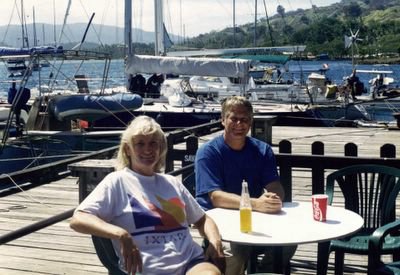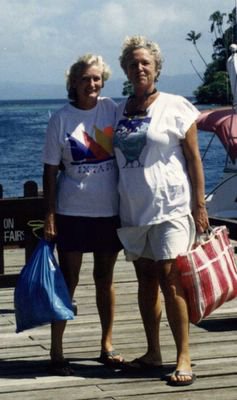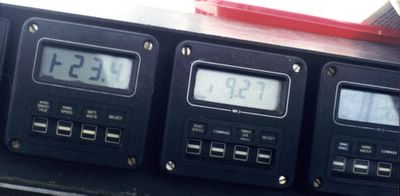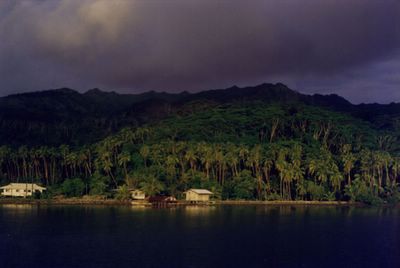August 24, 1998-Passage to Fiji
 August 24, 1998-Passage to Fiji & the Town of Savu Savu The trade winds have been particularly strong this year and this has been aggravating. First we were pinned down in Bora Bora for two weeks. Then we experienced rip roaring sailing on the way to Samoa, and now we’ve got them again on the way to Fiji. It wasn’t supposed to be this way on this trip. We waited in Samoa until we got a fairly good weather forecast from crusty and lovable Des on Russell Radio. He’d predicted 15 knots out of the east, and that’s also what the weather faxes showed, but when we got out there it was screaming, more like 35 knots. Judy and I just looked at each other. When we next checked in with Des Judy reported the wind strength we were experiencing and he was astonished, couldn’t fathom where they were coming from, and I clearly could hear some skepticism in his voice at what we said we had. But he simply said we should have 15 knots the next day, so on we went, hoping it would get better. No, when the next day dawned we still had 35. This went on for the whole five day trip and in fact we had a howling wind right through the last night as we raced past Taveuni Island on our final approach to Savu Savu in another of those pitch black scary nights which we seem to have a bit too often. I never forget these kind of passages, where we are racing along blind through the night, knowing that off a few miles there is an island, hard and rocky and black, just calling our name, lying in wait. I know we are far enough away to be safe, but still, not being able to see it makes me nervous. I was much relieved when our GPS position indicated that we were past its southern point, and in the clear for the final run into Savu Savu. Savu Savu, on the other hand, was delightful and peaceful. Instead of strong winds and dark skies, when we arrived in Savu Savu Bay it was a calm, sunny and beautiful morning. Our friend Carol talked us in on the radio, since we didn’t have much in the way of charts for the area and didn’t actually know where the town of Savu Savu was. We found the bay, but not the town or anchorage. It was seven o’clock in the morning when we turned the corner into the bay and found ourselves lost, so we were real happy to hear her voice come back to us after we hailed “Elyxir, Elyxir, this is Wings calling”.  “Wings, Wings, this is Elyxir, welcome to Fiji!” “Wings, Wings, this is Elyxir, welcome to Fiji!”She told us that the town is tucked up in a back corner at the mouth of a river coming down from the mountains. We motored along and sure enough, there it was. Savu Savu was heaven after our experience of the last two months. It is protected, quiet, sleepy even, and scenic, with Palm trees swaying on nearby islands and tall mountains in the background. We backed Wings up to the sea wall at the Copra Shed Marina, concocted a Rube Goldberg boarding ramp to the shaky platform that manger Simon had built sticking out from the rocks, and rushed ashore for some hugs from Carol, who, with husband Bob Ely, had been sailing in the South Pacific for a year longer than us. It was Carol who had lured us to Fiji with the promise of an exciting regatta at Musket Cove, on Fiji’s West side, in September, and it was there that we were ultimately headed. But before we left for Musket Cove with Carol on board, we planned on a few days of relaxation in Savu Savu, exploring the small Indian community and catching up with Carol and Bob.  Savu SavuNew Friends in FijiSimon Savu SavuNew Friends in FijiSimonFred & Judy, SV Wings, Fiji Labels: sailing
August 19, 1998-Samoa Samoa
 Pago Pago Pago PagoNo amount of imagination can conjure up an accurate image of a foreign port before you arrive there. We really didn’t know what Pago Pago was going to look like, and when we first spotted the South Coast of American Somoa, after a fast six day passage from Bora Bora, we still didn’t know; it was just a gray featureless smudge on the horizon. As we got closer the mountains appeared, but there wasn’t a harbor to be seen, or even an opening to sail into. Finally the hills resolved into two distinct sides, the gap between became visible, and we sailed into what has been called one of the best harbors in the Pacific, past anchored ships, industrial blight, native Burres, and non-descript office buildings, engrossed at the passing scene, just trying to absorb it all. In every new port you are forced to make the mental adjustment from what you might have been expecting, even if you think you have no expectations, to what it actually is. Part of the real excitement of arriving at a new port is knowing that you will go through this process of discovery, of changing a place from just a name to a complete mental picture, with sights, sounds, and smells. Pago Pago might be one of the Pacific’s best harbors in the view of the US Navy, a great place to anchor aircraft carriers, but for a small sailboat, it leaves something to be desired. It is windy, rough, and stinky. What nature has presented, man has defaced. Pago Pago has been called the armpit of the Pacific, and we could see why: the rank smell of a fish cannery pervades the whole harbor. Picking an anchoring spot is more about finding some place where an eddy in the prevailing winds brings a clean whiff of the ocean rather than the thick corruption of dead fish. And wherever you anchor, you’ll be faced with a wet and choppy dingy ride, because the harbor is endlessly rough. We had to develop a new skill with our Avon, running it just off a plane with the bow sky high to deflect the spray, straight into the wind until we could make a right angle turn and cut across the waves to the dingy dock. But our first introduction to Pago Pago was not the anchorage, it was the “ wall”, a jagged piece of broken concrete, totally exposed to the wind and waves, where we were required to tie up to await our port clearance. We placed fenderboards between our hull and the wall and watched them quickly, and steadily, being ground away by that rough rock wall. We wondered if they would last until the officials finished with our paperwork. On the other hand, we soon discovered that Pago Pago had a kind of funky charm, which made us feel welcome and comfortable there. We could overlook the crude landing place and the miserable anchorage when there were guys like Blackie and the other cruisers who collected around Wings when we tied up and helped us with lines, or just gave us a friendly greeting. These guys had each landed in Pago Pago themselves some time in the past, on whatever leaky boat they could find to carry them there, and they sort of grew roots. God knows that they could never find a good thing to say about the place, but they just never left. The marina was small, too shallow for a deep keel sailboat, and there weren’t any free spots there anyhow, but there was a home-built float on the lee side of the quay, with a bundle of logs to walk on and a precariously balanced plank from the shore that you could reach if you scrambled down the bank to the water’s edge, and there on that float was one of the oddest and scruffiest collection cruising boats you’ll find anywhere, nothing like the glossy gold plater’s which populate most of the ports on the normal cruiser routes. But the sailors were a good lot, and they gave us tips about where to buy supplies and get a bite to eat, and were quick to offer a beer. We enjoyed Pago Pago, and wandered around Fa’Aotaota poking into dusty stores, looking for the provisions we came here to buy. We rode the local buses, each one overloaded with supersized Samoan’s, and we even found a stationary store with a computer in the back where we could get onto the internet and do some email. A trip to the other side of the island brought us to a Costco store and it was like being back in the USA. We bought bags of supplies, at US prices, and packed them back to the boat, our mission to Pago Pago accomplished. So that was Samoa. Not much as a destination, and probably not as nice as Western Samoa, the independent country just 37 miles west which has a better reputation among cruisers, but it served it’s purpose for us, and after a few days, we were off again, headed for Fiji. Fred & Judy, SV Wings, Pago Pago Labels: Samoa
August 11, 1998 Dash to Samoa
 9.27 knots 9.27 knotsThere was this guy at the bar at the Sloop Tavern in Seattle with long hair and leathery, sunburned skin, looking generally scruffy and disreputable, but he had a friendly, easy demeanor, and he was entertaining the regulars with his stories from the South Pacific. He said for the last ten years he’d been living on his boat in Pago Pago, only it was pronounced Pango Pango, and he was soon to go back there. To a land bound sailor like me, stuck in Seattle, with dreams of the South Pacific already filling my head, it struck a note. I didn’t have any idea where exactly in the South Pacific Pago Pago was, but I was surely going to go there. Maybe I’d hang out there for 10 years too. So we left Bora Bora with three other boats on that windy day in early August, 1998, and set sail for Pago Pago, in American Samoa. The others were heading to Nuie or Tonga, or some other atoll somewhere, and they diverged on courses more southerly than ours. Few boats had much interest in American Samoa with it’s reputation of being the armpit of the Pacific, trashy, smelly, and unfriendly, but it was supposed to be a good stop for provisioning. And that guy in the Sloop Tavern made it sound romantic. The trades were still active, still reinforced, and the other boats quickly reefed down, but we were flying, and I didn’t see any point in slowing down. With a full main and poled out number four we rocked on and powered our way westward, consistently seeing 8’s and 9’s on the dial. We talked on the radio to Isis and the others and they were incredulous that we hadn’t reduced sail. But this passage was going to be a speed run if I had my way. We’d been in lighter air most of the way across the Pacific, and we were behind schedule. Now that we had the wind, I wanted to get some big numbers in the log book, and we did. On this passage we logged 201 miles noon to noon on one day, and had a couple of days over 195, but it wasn’t fun. On Wings speeds over nine knots are hard to get, hull speed firmly limits us to the mid eights, but with big waves and strong winds, if you push it, you can surf ahead into those nines and even sometimes touch 10 knots. Between the waves you’re going to drop to the mid sevens. To get the average up you have to hold the pedal to the metal. The loads on the boat, however, get dangerously high. The sheets and guys are bar tight, the mast creaks and groans, and the wind vane is making sounds that no one likes to hear, straining and creaking as it tries to horse this big rolling and swerving machine back onto some semblance of a straight line.  Windvane having a workout Windvane having a workoutThen there is the water rushing by. At nine knots it is the roar of a mountain waterfall, and the waves around your stern sound like they have boulders in them. In the kind of winds it takes to push this boat at those speeds you get noise in the rig too, a howling moan that reminds you of demons from hell. At night it is all worse, you can’t see a thing, but to get 200 miles in this boat, you have to keep going all night too. On my night watches I sat there in the dark looking at yellow glow of the speedometer, watching the numbers clock up in synch with the sounds of the water as it increased it’s roar on those big surfs. It was mesmerizing, but I couldn’t relax, I could only hang on and wait, fully alert, for something to go wrong. On some boats the sound down below is worse than on deck, as the hulls seem to amplify every noise, but on Wings, particularly downwind, sometimes it seems almost calm down below, even as the scene on deck borders on chaos. You lie on the leeward sea berth and look up through the hatch at your partner standing watch there, and it seems serene, peaceful. It is easy to get hopeful, from that soft, warm, off-watch nest, that the wind is down, that the speeds are off a bit. You ask the watch stander, “Is the wind down?” and it is a shock when the answer comes back, “No, it’s still over 35 most of the time.” As an afterthought, they add, “But we seem to be doing OK in it.” If it’s Judy down below, she’ll then ask, “Should we reef?” and I’ll say something sharp, like, “Reef, why reef? We’re doing fine.” As much as I like the speeds, I do feel the stress, but for Judy I know it is worse. While I watch the speedometer, looking for the big numbers, she is watching the true windspeed, dreading the big numbers there. We know each other well enough so I know how she feels and what she is going to say, just as she knows my answer. But if I have my mind made up, if I say the decision is to carry on, she keeps her peace and doesn’t complain; until the next watch, when she wakes up hopeful again of a drop in the wind, and we go through the same ritual. Well, nothing bad happened on this trip, and on the afternoon of the sixth day we arrived at Teama Bank, off the entrance to Pago Pago Harbor. We’d averaged 180 nautical miles per day since leaving Bora Bora Fred & Judy, SV Wings, Pago Pago Labels: sailing
August 4, 1998- Wandering Aimlessly Through the Societies
 Part 1 Part 1One night in Papeete as I sat in the cabin with a cold Hinano beer contemplating a chart of the Society Islands. I asked Judy, “Which islands do you want to stop at; there are six”, and I listed them: “Tahiti, Moorea, Bora Bora, Huahine, Raiatea, Tahaa and Maupiti”. We were already at Tahiti, so there were six more. “All of them” She answered, without hesitation. Maybe it surprised me; we’d been skipping along pretty fast since we hit Polynesia, stopping only here and there, but I accepted it. She wants to stop at all of them, we’ll stop at all of them. In the end we skipped Maupiti; after getting hung up at Huahine and Bora Bora we had to in order to make it to Fiji for the Musket Cove Regatta by early September. Still visiting the other five was a decently thorough tour of the Societies. “I guess we’d better get going in a day or two then”, I answered, and I started to plan an itinerary. Moorea.A couple of days later we cast off our shore lines and stood out of the pass, bound for Opunoho Bay, on Moorea, 35 miles away. It felt good to be at sea again, reaching across the SE Trades, rising and falling in the heavy pacific swell. That same afternoon we were anchored in Robinson's Cove, with stern lines ashore, next to our friends on Annapurna, and looking out our hatch at Mt Tohiea’s famous profile. The place looked and felt like the movie set for South Pacific. It was. It was fun to hook up with Buddy and Ruth on Annapurna. We’d sailed with them in Mexico, including that long hot, summer in the Sea of Cortez, and crossed the Pacific the same month, so we hung out with them for a few days exploring Moorea. A dingy ride out to the reef quickly revealed that the coral was mostly dead and bleached, and there were no fish. We found ourselves taking walks around Opunoho Bay’s shoreline instead of going diving, seeing native homes and meeting natives; plus we saw a flock of sheep and a cow; pretty exciting. One day a family, (a man and two children) paddled out on half of a surf board to visit us. We had a polite conversation with them but we didn’t invite them aboard. On another day we hiked up Mt Tohiea to the Belvedere lookout, and a day or two day before we left Moorea we took the bus to Cook’s Bay, then to Afareaitu, and the high speed ferry to Tahiti where we visited Jim and Annie on High Roler, just arrived from Mexico. We got back to Opunoho Bay after dark and we couldn’t see where to have the bus stop to let us off. In the end we went past the place where the boats were tied to shore and we had to stumble back in the dark. So that was Moorea; other than the scenery, not much for us here. Off to the next island. Click here for more.Fred & Judy, SV Wings, Bora Bora Labels: Polynesia
August 4, 1998-Part 2-Huahini to Bora Bora
 Huahine Huahine
Click here, for part 1 of this storyOn another glorious trade wind day we set sail across a sparkling blue ocean for Huahine, close reaching with flags flying, and watched the island on the horizon grow bigger. Soon we rounded the south end of Huahine and hardened up to sail close hauled on the leeward side, just off the breakers of the reef, until we got to the pass at Fare. The anchor splashed down in gin clear water over white sand off that small, sleepy, town. Fare looked dumpy from the boat, and going ashore, we found it to be so, but the lagoon was drop dead gorgeous. Somewhere I’d read a report from another boat that said they had found paradise almost all the way to the south end of the island, down inside the reef, so we set off motoring south inside the reef, winding our way carefully from mark to mark, looking for the holy grail of anchoring spots. Finally, and only after very carefully squeezing through a shallow twisting bit where the navigation aids were curiously missing, we poked our way into a broad and beautiful bay with a white sand beach overhung with coconut palms that stretched out for a mile ahead of us. Offshore, in the distance we could see the surf breaking on the reef, and hear its steady thunder, but in this unnamed bay, all was quiet. It looked untouched. We enjoyed our stay on beautiful Huahine but it turned out to be a bit longer than we’d planned. The day after we arrived the wind came up we found ourselves trapped, unable to get back over the shallow spot where we had come into the bay because of wind driven waves which obscured the bottom and therefore the path through, not that we didn’t try. We attempted it twice, creeping forward inch by inch, trying not to touch, and at times we had the engine in reverse to stem our forward progress in the current. Finally, with the keel just inches above the coral, and a three knot tide running, we gave up and returned to the anchorage. Another boat, Shedir, had also found its way down there and was marooned in the bay like us. Shedir was a fine 49ft sloop flying the Swiss flag, sailed by Marcus and Verena. We spent some time with them and their guests from Switzerland at Huahine, and learned a lot from these two very capable young German Swiss sailors. When we did go ashore we shared exotic cocktails and cold beers, at a little resort on the beach, it was a good time, but we were itching to go. A week later the wind dropped and we got out. Raiatea & Tahaa
Next we sailed to Raiatea and came flying in the pass with islands and breakers on either side, and small boats sailing nearby, and found our way to the small marina on the north shore. After a short overnight stay in the marina and a trip to the supermarket, we departed Raiatea to look for some nice place to stay over on Tahaa. Click here, to see the Carenage at Raiatea. That evening we motored in a dark gloom deep into the island where a bay penetrated, with rain softly falling and lights reflecting off the still waters, and anchored off a school. It looked like some place in Washington State, quiet, dark, still.  Further on around the island in the days after we passed close to the shore and saw numbers of small homes or businesses along the water’s edge, and we enjoyed the sightseeing, but again, we didn’t want to stay. We were restless and needed to keep moving. We wandered from place to place like a fickle lover, never finding any place we wanted to be with for more than a one night stand. The last night in Tahaa we anchored off the island’s west side, and could see Bora Bora in the distance. It seemed to call to us.  Bora Bora callingBora Bora Bora Bora callingBora Bora
Reinforced Trades. That’s what the weather was called, and it meant thirty knots of wind blowing all day and night. We got into Bora Bora safe enough, despite the wind, but all we could do after we arrived was hunker down in a protected anchorage with the other cruisers behind a small island just inside the pass. The wind kept up and more boats arrived and it got a bit crowded.. With the wind and currents we mostly felt we had to stay on the boats, trying to keep from getting too close to a neighbor, and waiting out the wind, and hoping for a chance to go move around to the shallow lagoon on the east side where it was supposed to be the best snorkeling anywhere. We never made it. Bora Bora peakIn early August 1998, we gave up on the idea of an idyllic visit to Bora Bora, which we had been looking forward to, and saying farewell to French Polynesia, sailed with three other boats for points west.  Fred & Judy, SV WINGS, Bora Bora Labels: Polynesia, sailing
NEXT Page (More)
, or... GO BACK to Previous Page
|

 “Wings, Wings, this is Elyxir, welcome to Fiji!”
“Wings, Wings, this is Elyxir, welcome to Fiji!” Savu Savu
Savu Savu
 Pago Pago
Pago Pago 9.27 knots
9.27 knots Windvane having a workout
Windvane having a workout


 Bora Bora calling
Bora Bora calling
.jpg)
